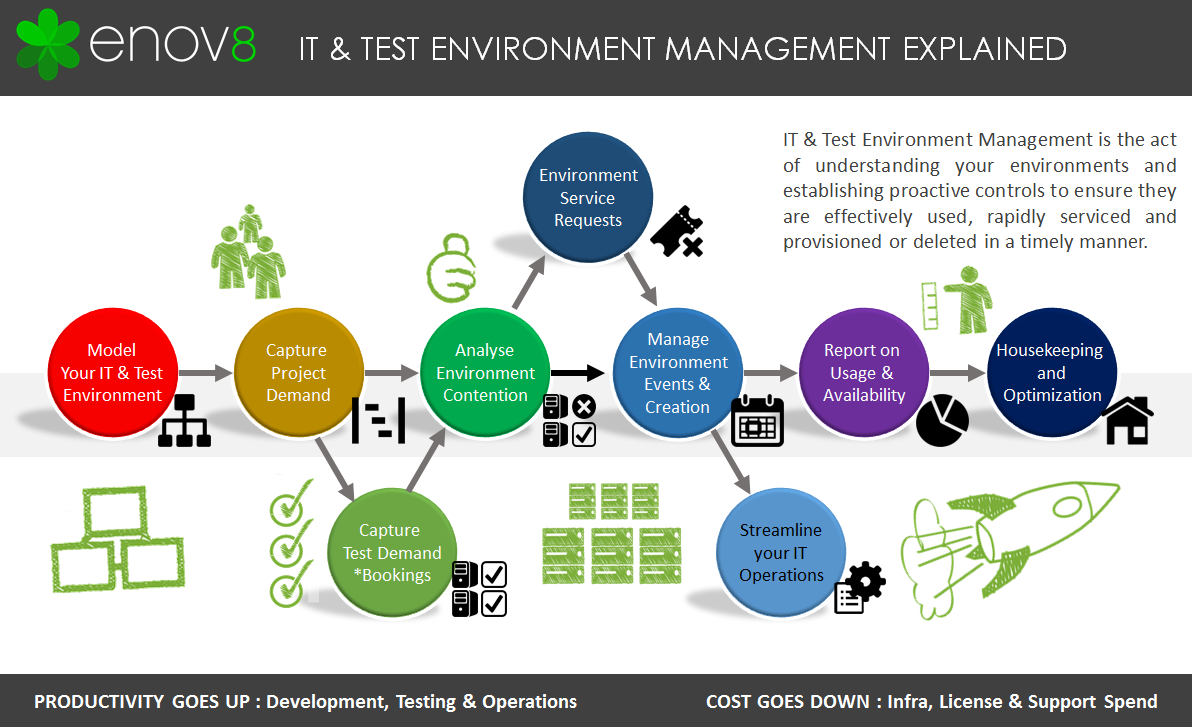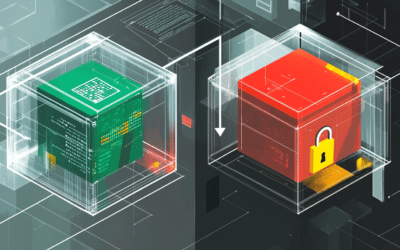
Test Environment Management Explained
JUN, 2022
by the Enov8 Team.
This post was originally written by Erik Dietrich, Ukpai Ugochi, and Jane Temov. Modified for re-publication by Eric Goebelbecker.
Eric Goebelbecker Eric has worked in the financial markets in New York City for 25 years, developing infrastructure for market data and financial information exchange (FIX) protocol networks. He loves to talk about what makes teams effective (or not so effective!).
Most companies spend between 45%-55% of their IT budget on non-production activities like Training, Development & Testing and lose 20-40% of productivity across their software testing and software development lifecycle. This is because the art of “Test Environment Management” (or TEM) is still an area of significant confusion.
Enov8 IT & Test Environment Manager
*Innovate with Enov8
Streamlining delivery through effective transparency & control of your IT & Test Environments.
Definition of TEM
In the hope of educating and raising the bar on Test Environment Management, here’s a quick overview of “IT & Test Environment Best Practices” from Enov8.
Definition: IT & Test Environments Management is the act of understanding your production environment and cross-life-cycle test environments. It includes establishing controls to ensure your teams use them effectively and rapidly, service, provision, and delete them on time.
Why Is the Test Environment Management Process Important?
In the ever-evolving IT/Software field, requirements continually change, creating a complex interplay between cost, quality, and time. While high-quality products can be achieved with adequate budget and time, projects often exceed these constraints, resulting in compromised product quality.
One reason for poor quality products is the inadequate prioritization and inefficient management of test environment management. Regulatory compliance, such as Sarbanes Oxley, underscores the importance of ensuring software and services comply with industry norms and business requirements. Therefore, effective test environment management processes are crucial to delivering high-quality products within budget and time constraints.
Test Environment HotSpots
Test Environment HotSpots are critical areas within a test environment that require special attention to ensure the smooth functioning of the environment. These hotspots can be any part of the environment that can potentially cause issues, such as configuration problems, resource allocation, or dependencies.
One of the most common hotspots is the hardware and infrastructure of the environment. It is crucial to ensure that the hardware is capable of handling the testing load and that it is adequately configured. For example, insufficient memory or storage can lead to performance issues, while inadequate network capacity can cause delays or interruptions in testing.
Another hotspot is the test data, which should be carefully managed to ensure it is accurate and relevant. Testing with incomplete or incorrect data can lead to false positives and false negatives, which can result in significant costs and delays.
Integration points with other systems, such as third-party applications, databases, and APIs, are also potential hotspots. It is essential to ensure that these integration points are thoroughly tested and validated, and that any changes to the system do not affect the functionality of the test environment.
Finally, the configuration and deployment of the application being tested are critical hotspots. Changes to the application code, software patches, and upgrades can impact the test environment and cause issues. Therefore, it is necessary to have a reliable and repeatable deployment process, and to test the application thoroughly before deploying it to the environment.
To manage these hotspots effectively, it is essential to conduct regular assessments of the environment, identify potential issues, and implement best practices to address them. This approach ensures that the test environment is reliable, effective, and supports the testing process as a whole.
The Enov8 Test Environment Use Case
The Key Test Environment Management Activities You Should Consider
Here is a list of the key TEM best practices you should consider implementing.
Knowledge Management / Modelling
Know What Your IT & Test Environments Looks Like
Start with the process of modeling your Production Environment and Testing Environment. Including key configuration items like environment groups, systems, environment instances, components, microservices, relationships, and test data. It’s essential if we are to understand our platforms and end-to-end architecture truly.
Visualization and awareness contribute to better decision-making, servicing, and troubleshooting of our testing environment and help us better understand and support our production environment.
Demand Management
Capture Demand Across Your Testing Environments
Development and software testing teams need access to specific test environments throughout the software development process. To avoid conflict and optimize the use of company resources, it is important to have a system in place that captures and manages demand for test environments. This is where test environment booking management comes in.
Test environment booking management is a system that records the date, time, and duration of each team’s requested use of a test environment. You can use this information to schedule and allocate resources accordingly.
Streamline via Environment Automation
Streamline Your Test Environments Preparation Through the Use of Automation
Invest in the orchestration (aka scripting) for key Test Environment tasks like Deployment Provisioning, Rollback, Decommissioning, and Test Bed Health checks.
Tip: If it takes more than an hour to prepare a test environment, there’s something wrong. Perhaps it is time to review your approach.
Testing Environments Planning & Coordination
Plan & Coordinate Test Environment Activity
The Test Environments Management process is responsible for managing and proactively scheduling test environment activities.
Use calendaring to coordinate operations across your test environments and ensure that you complete your testing environment preparation tasks in a timely and organized manner.
Tip: Attach the use of implementation plans (aka deployment plans) for more complex events. For example, create a ‘deployment implementation plan.’
Streamline via Standardised Operations
Keep Test Environments Preparation Repeatable with SOPs
Use test environment runsheets and implementation plans to coordinate TEM operations and ensure test environment preparation tasks are completed in a timely and organized manner. Timely environments contribute to more software development and software testing time.
Tip: Employ this approach across all your Testing Environment tiers, i.e., Infrastructure, Applications, and Test Data. And across the lifecycle, i.e., the Software Development Environment, Test Environments like your Integration Testing Environment, Staging Environment, Performance Testing Environment, and of course, your Production Environments.
Optimize Through Insights
Value Stream Through Environment Status Accounting & Reporting
Drive continuous improvement through up-to-date insights on test environment behavior.
Use real-time data feeds and dashboards to better understand your environment footprint, test environment usage, systems availability, and the various system teams’ service capability.
Watch Our TEM Video to Learn More:
Conclusion
In conclusion, Test Environment Management (TEM) plays a crucial role in software development and testing. It is essential to manage and maintain the various testing environments to ensure the delivery of high-quality software. TEM enables effective collaboration between developers, testers, and other stakeholders and helps identify and mitigate potential risks early on in the development process. By implementing a comprehensive TEM strategy, organizations can improve software quality, reduce downtime, and ultimately deliver better products to their customers. With the growing complexity of software development and testing, TEM has become increasingly important, and it is essential for organizations to invest in effective TEM practices to stay ahead of the competition.
Next Steps on your TEM Journey
Rate your TEM Maturity using Enov8 Maturity Index. A great tool that you can use independently, or as part of a team.
Find the TEM Return on Investment using the Enov8 TEM ROI Calculator. Use Test Environments Management to drive “productivity up” across your IT Operations, Projects, Development & Testing and conversely, drive “IT cost down” across your Infrastructure, License & Support Spend.
Other Reading
Enov8 Blog: Your Essential Test Environment Management Checklist
Enov8 Blog: What makes a good Test Environment Manager
Enov8 Blog: Understanding the Types of Test Environments
Relevant Articles
RAG Status: What It Is and Using It for Project Management
Effective Leadership requires effective tooling to drive successful outcomes. One tool they can use to monitor and measure progress is RAG status. RAG stands for Red, Amber, Green, and is a simple traffic light system used to communicate the current status of a...
Enterprise Architecture Tools: 11 to Be Aware Of in 2025
Enterprise architecture (EA) is an essential discipline for organizations aiming to align their IT strategy with business goals. As companies become more complex and technology-driven, having the right set of EA tools is crucial to streamline operations, improve...
What is a Staging Server? An Essential Guide
Release issues happen. Maybe it’s a new regression you didn’t catch in QA. Sometimes it’s a failed deploy. Or, it might even be an unexpected hardware conflict. How do you catch them in advance? One popular strategy is a staging server....
What is Deployment Planning? A Detailed Guide
Deployment planning, sometimes referred to as "implementation planning," is the process of creating a plan for the successful deployment of a new software or system. It involves identifying the resources, tasks, and timeline needed to ensure that the deployment is...
The Definitive Guide to Test Data Generation
Test data generation is a critical part of the software testing lifecycle, ensuring that applications are tested against realistic scenarios before going live. If you’re not testing against production-like data, you’re arguably not truly testing your application. In...
What is a Test Data Manager? A Detailed Introduction
Testing is a critical aspect of software development, and it requires the use of appropriate test data to ensure that the software performs optimally. Test data management (TDM) is the process of creating, storing, and managing test data to ensure its...












